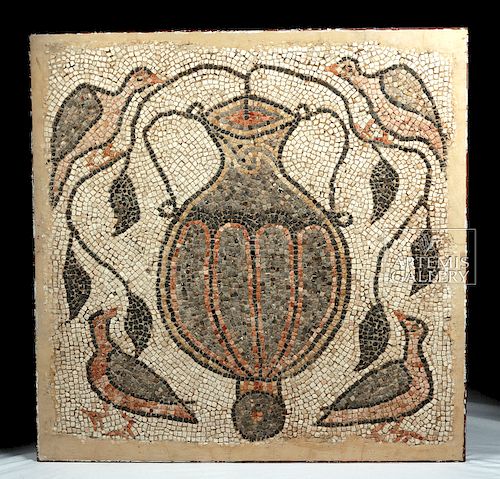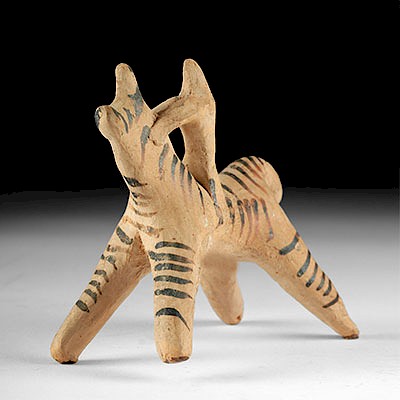Roman / Byzantine Mosaic - Birds, Vessel, & Leafy Vines
Lot 98a
About Seller
Artemis Fine Arts
686 S Taylor Ave, Ste 106
Louisville, CO 80027
United States
Selling antiquities, ancient and ethnographic art online since 1993, Artemis Gallery specializes in Classical Antiquities (Egyptian, Greek, Roman, Near Eastern), Asian, Pre-Columbian, African / Tribal / Oceanographic art. Our extensive inventory includes pottery, stone, metal, wood, glass and textil...Read more
Estimate:
$18,000 - $25,000
Absentee vs Live bid
Two ways to bid:
- Leave a max absentee bid and the platform will bid on your behalf up to your maximum bid during the live auction.
- Bid live during the auction and your bids will be submitted real-time to the auctioneer.
Bid Increments
| Price | Bid Increment |
|---|---|
| $0 | $25 |
| $300 | $50 |
| $1,000 | $100 |
| $2,000 | $250 |
| $5,000 | $500 |
| $10,000 | $1,000 |
| $20,000 | $2,500 |
| $50,000 | $5,000 |
| $100,000 | $10,000 |
| $200,000 | $20,000 |
About Auction
By Artemis Fine Arts
Oct 25, 2018
Set Reminder
2018-10-25 11:00:00
2018-10-25 11:00:00
America/New_York
Bidsquare
Bidsquare : Antiquities from Egypt, Greece, Italy, Asia
https://www.bidsquare.com/auctions/artemis-gallery/antiquities-from-egypt-greece-italy-asia-3538
Featuring Egyptian, Greek, Roman, Etruscan, Near Eastern, plus Asian art from Central and Far East. If you love the classics, this is the sale for you. Artemis Fine Arts info@artemisgallery.com
Featuring Egyptian, Greek, Roman, Etruscan, Near Eastern, plus Asian art from Central and Far East. If you love the classics, this is the sale for you. Artemis Fine Arts info@artemisgallery.com
- Lot Description
Late Roman or Early Byzantine, the Levant, late Imperial Period, ca. 4th to 6th century CE. A well-executed mosaic composition depicting four birds - perhaps doves or quail - surrounding a large central twin-handled amphora with a peg toe and a wide mouth from which leafy vines extend and fall to either side. All is delineated in orange, black, grey, and cream stone tesserae, mounted in a modern cement matrix with a metal frame for support. The attention to detail is impressive, as the mosaicist carefully delineated the avians' eyes, beaks, wings, feathering, and perched feet - as well as the pointed leaves emerging from the naturalistically rendered stems. The colorful birds, foliage, and vessel are set against a creamy white ground. The volumes of the forms are skillfully modeled with color so as to create a somewhat three dimensional effect. Size: 35.75" W x 35.75" H (90.8 cm x 90.8 cm)
Birds - and indeed, animals of all kinds - were incredibly popular artistic themes in the Roman Empire. Romans delighted in seeing animals, and a major industry during the imperial period was the capture and transport of birds, mammals, and lizards for display and sport in the Roman arena. Ancient Roman mosaic artwork reflects this interest. For example, at Pompeii, there are multiple mosaics depicting well-rendered, lifelike birds engaging in a variety of activities - sitting in trees, warily watching cats, and in the case of one partridge, plucking at a necklace as if to steal it. Based on where mosaics depicting them have been found, birds seem to have been considered tranquil, peaceful subjects for the interiors of homes (not so the case with many other types of animals).
Mosaics (opus tesellatum) are some of our enduring images from the Roman world, not only for their aesthetic beauty, but also because they reveal what Romans chose to depict and see every day decorating their private and public spaces. In the Roman province of Syria, which encompassed most of the ancient Near East/Levant, mosaics seem to have developed as a common art form relatively late, with most finds coming from the 3rd century CE or later. Syria was one of Rome's wealthiest provinces, but it was also far removed from Rome itself and Roman culture was overlaid on enduring cultural traditions from Hellenistic Greece and the great civilizations that came before it. Antioch-on-the-Orontes (modern day Antakya, Turkey), was the capital of northern Roman Syria, and its excavations in the 1930s revealed more than three hundred mosaic pavements.
Provenance: private East Coast, USA collection, acquired in the 1970s from the collection of Dr. Gary Karch, Florida, USA, purchased in Israel
All items legal to buy/sell under U.S. Statute covering cultural patrimony Code 2600, CHAPTER 14, and are guaranteed to be as described or your money back.
A Certificate of Authenticity will accompany all winning bids.
We ship worldwide and handle all shipping in-house for your convenience.
#138663Expected age wear. Losses to peripheries as shown. A few minor losses to interior tesserae as shown. Set into modern plaster matrix with metal framing. Some missing recessed screws. A few cracks to the plaster matrix visible at margins and verso, one section of matrix on verso appears to have been replaced.Condition
- Shipping Info
-
All shipping is handled in-house for your convenience. Your invoice from Artemis Gallery will include shipping calculation instructions. If in doubt, please inquire BEFORE bidding for estimated shipping costs for individual items.
-
- Buyer's Premium



 EUR
EUR CAD
CAD AUD
AUD GBP
GBP MXN
MXN HKD
HKD CNY
CNY MYR
MYR SEK
SEK SGD
SGD CHF
CHF THB
THB














